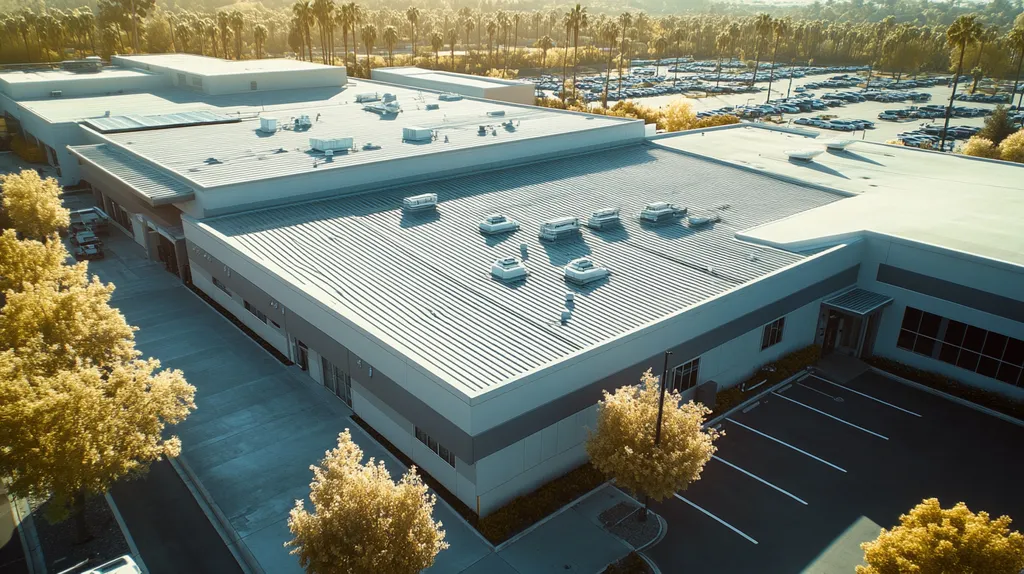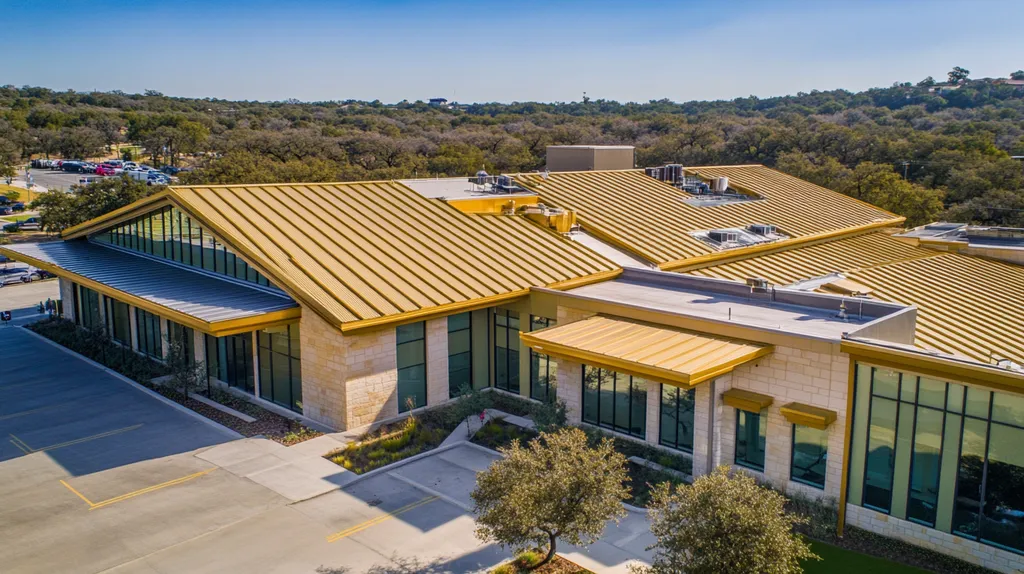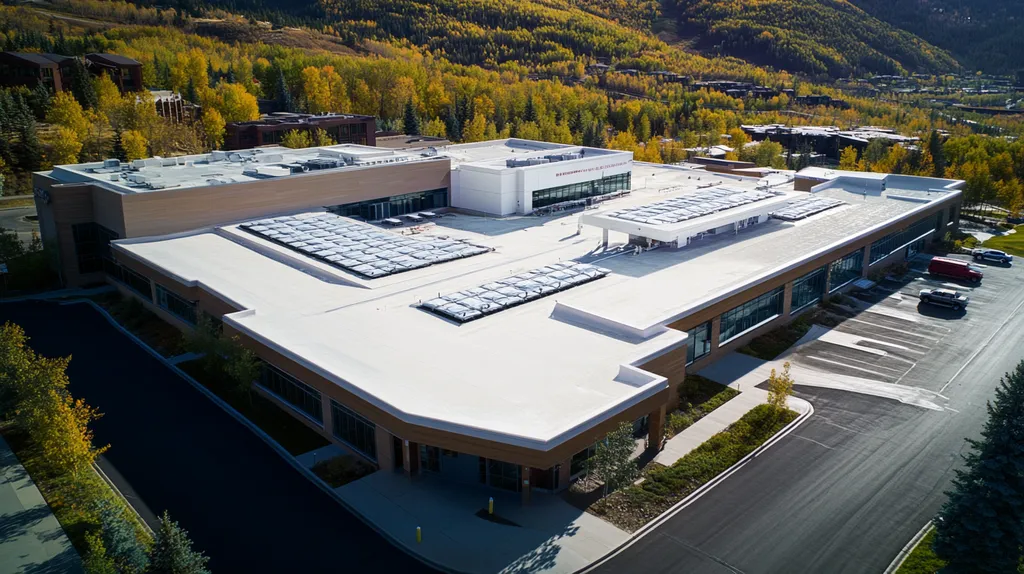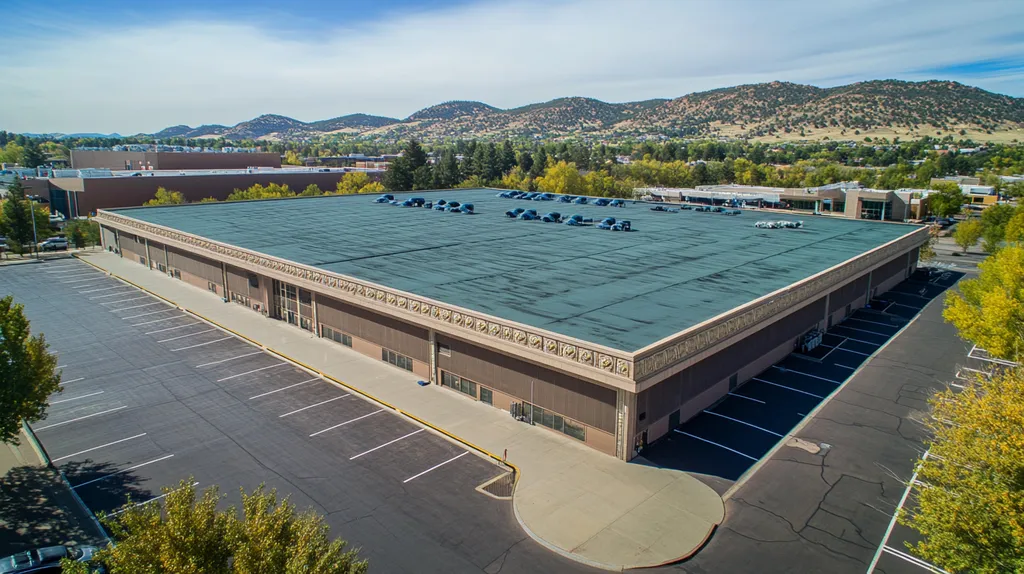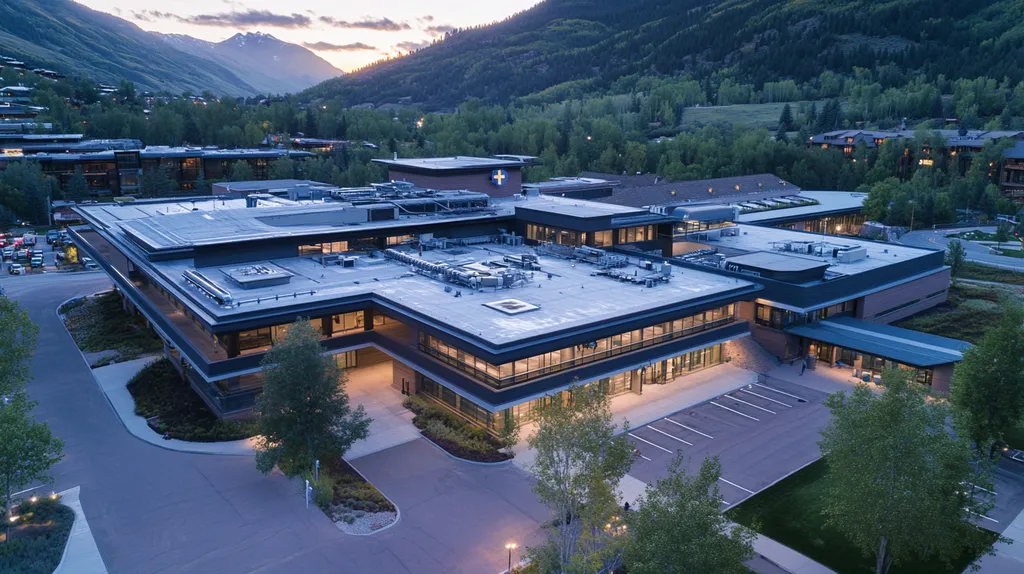The industrial roofing sector generates over 11 million tons of waste annually while consuming massive amounts of energy through inefficient designs and materials. This environmental impact continues to accelerate as more than 50 billion square feet of commercial roofing approaches replacement age.
Traditional roofing practices no longer align with modern environmental imperatives, yet the industry remains locked into unsustainable patterns through outdated regulations and misaligned market incentives.
This analysis examines why conventional environmental approaches are failing and identifies crucial opportunities for meaningful change in industrial roofing practices.
SECTION 1: CURRENT PRACTICES
Industrial roofing stands at a critical environmental crossroads. While traditional practices have served immediate business needs, their environmental impact has become increasingly unsustainable. Each year, millions of square feet of industrial roofing contribute to environmental degradation through material waste, inefficient energy performance, and harmful production processes. Understanding these challenges is essential for facility managers seeking to balance operational needs with environmental responsibility.
Prevalence of Asphalt Shingle Roofing in Industry
Asphalt shingles dominate industrial roofing, covering approximately 80% of commercial and industrial buildings in North America. This widespread adoption stems from their relatively low initial cost and familiar installation process.
The environmental cost of this preference is substantial. These materials typically require replacement every 15-20 years, creating a continuous cycle of waste generation and resource consumption.
Manufacturing processes for asphalt shingles consume significant amounts of petroleum products, contributing directly to carbon emissions. The production of enough shingles for a typical industrial roof releases approximately 2,000 pounds of CO2 into the atmosphere.
Despite recycling possibilities, over 90% of removed asphalt shingles end up in landfills, where they take up to 300 years to decompose.
Energy Efficiency Measures in Standard Roof Designs
Current energy efficiency approaches in industrial roofing often focus on minimal compliance rather than optimal performance. Standard white roof coatings and basic insulation packages represent the most common energy-saving measures.
Traditional roofing systems typically achieve only 30-40% of their potential energy savings due to inadequate design integration and poor material selection. This shortfall results in unnecessary energy consumption and increased operational costs.
Green roofs offer a superior alternative, reducing air-conditioning demand while removing pollutants through carbon sequestration. These systems can reduce stormwater runoff by 60 to 100 percent while significantly improving urban climate mitigation. (source: U.S. Environmental Protection Agency)
Most existing industrial roofs lack comprehensive monitoring systems, making it difficult to track and optimize energy performance over time.
Conventional Material Production and Waste Disposal
The industrial roofing supply chain remains heavily dependent on petroleum-based products and energy-intensive manufacturing processes. Current production methods generate significant greenhouse gas emissions and toxic byproducts.
Standard manufacturing facilities for roofing materials consume approximately 12 million BTUs of energy per ton of finished product. This energy intensity contributes substantially to the industry’s carbon footprint.
Waste disposal practices continue to rely primarily on landfilling, with less than 10% of roofing materials being recycled or repurposed. The construction industry generates over 100 million tons of waste annually, with roofing materials representing a significant portion.
Alternative production methods and recycling programs exist but remain underutilized due to perceived cost barriers and lack of regulatory incentives.
SECTION 2: SYSTEMIC ISSUES
Industrial roofing faces three critical environmental challenges that demand immediate attention. Current roofing practices contribute heavily to landfill waste, with over 15 billion square feet of roofing materials discarded annually. The combination of petroleum-based materials, inefficient recycling, and heat-absorbing surfaces creates a compound effect that accelerates environmental degradation.
Environmental Impact of Petroleum-Based Roofing Materials
The production of petroleum-based roofing materials releases significant quantities of volatile organic compounds (VOCs) and greenhouse gases. A typical manufacturing facility processing these materials consumes enough energy annually to power 2,000 homes.
These materials contain toxic compounds that can leach into soil and groundwater when improperly disposed of. The chemical composition of traditional roofing products makes them particularly resistant to natural decomposition.
Manufacturing processes for petroleum-based materials require extensive water usage, with a single production facility consuming up to 50,000 gallons daily. This water often becomes contaminated with industrial chemicals, requiring extensive treatment.
Alternative materials like recycled metal, bio-based membranes, and photovoltaic-ready surfaces offer significantly reduced environmental impacts while maintaining durability standards.
Inadequate Recycling and Roofing Waste Management
Current waste management infrastructure struggles to handle the volume and complexity of roofing materials. Less than 5% of commercial roofing waste undergoes proper recycling, with the remainder occupying valuable landfill space.
The mixed composition of many roofing materials complicates recycling efforts. Separating components like metal fasteners, insulation, and weatherproof membranes requires specialized equipment and processes rarely available at standard recycling facilities.
Transportation costs and limited processing facilities create additional barriers to recycling. Many regions lack dedicated facilities within economical hauling distance, making landfill disposal the default option.
Innovative recycling programs have demonstrated that up to 95% of roofing materials can be successfully reclaimed when proper systems are in place. These programs create new revenue streams while reducing environmental impact.
Urban Heat Island Contribution from Dark Roof Surfaces
Dark roofing surfaces significantly amplify urban heat island effects. These surfaces can reach temperatures up to 90°F hotter than the surrounding air, creating localized climate impacts that extend well beyond the building footprint.
The heat absorption and retention characteristics of traditional dark roofs increase cooling costs and strain HVAC systems. This additional energy consumption creates a feedback loop of increased carbon emissions and urban warming.
Large industrial roofs act as heat reservoirs, continuing to warm surrounding areas even after sunset. This persistent heat retention disrupts natural cooling cycles and affects local ecosystems.
Reflective roofing materials and green roof systems offer proven solutions for mitigating heat island effects. Green roofs can reduce stormwater runoff by 60 to 100 percent while providing significant urban climate benefits. (source: U.S. Environmental Protection Agency)
SECTION 3: MISSED OPPORTUNITIES
Industrial roofing stands at a critical junction where overlooked opportunities could transform building performance. Current estimates suggest that 85% of industrial roofs fail to capitalize on readily available sustainability features. This oversight costs facility owners millions in excess energy spending while contributing unnecessarily to environmental degradation.
Underutilization of Metal and Reflective Roofing Systems
Despite proven benefits, less than 20% of industrial facilities leverage metal and reflective roofing systems effectively. These materials can reduce peak cooling demands by up to 40% while lasting twice as long as traditional roofing materials.
Initial cost concerns often overshadow long-term savings potential, leading to short-sighted material choices. A typical 50,000-square-foot industrial roof using traditional materials can cost an additional $15,000 annually in unnecessary cooling expenses.
Advanced coating technologies now allow metal roofs to achieve solar reflectance values exceeding 85%. This dramatic improvement in performance makes metal roofing increasingly viable for warm-climate installations.
The durability of metal systems, often exceeding 40 years, provides substantial lifecycle cost advantages over traditional materials that require replacement every 15-20 years.
Potential for Enhanced Roof Longevity through Design
Poor design integration remains the leading cause of premature roof failure in industrial buildings. Simple improvements in drainage patterns, material transitions, and structural support can extend roof life by 50% or more.
Most industrial roofs lack basic preventive features like proper expansion joints and reinforced perimeter attachment. These oversights lead to accelerated deterioration and increased maintenance costs.
Strategic placement of mechanical equipment and service paths can dramatically reduce wear patterns. Yet fewer than 30% of industrial roofs incorporate these basic design considerations.
Modern design techniques, including 3D modeling and stress analysis, allow for precise optimization of roof systems. These tools remain underutilized in industrial applications, where standardized designs still dominate.
Lack of Integration with Building Energy Management
The disconnect between roofing systems and building energy management represents a massive efficiency gap. Most industrial facilities operate their HVAC systems without any consideration of roof surface temperatures or conditions.
Green roof systems offer exceptional opportunities for energy management and environmental benefits. These systems can reduce stormwater runoff by 60 to 100 percent while significantly improving urban climate mitigation. (source: U.S. Environmental Protection Agency)
Smart monitoring systems can detect temperature variations and moisture infiltration in real-time. This technology enables proactive maintenance and energy optimization, yet remains implemented in less than 5% of industrial roofs.
Integration of solar panels and daylight harvesting systems could reduce facility energy costs by up to 30%. However, most industrial roofs lack the necessary structural planning and electrical infrastructure for these improvements.
SECTION 4: ROOT CAUSES
The industrial roofing sector faces a critical sustainability challenge, with current practices contributing significantly to environmental degradation. Studies show that commercial buildings generate nearly 20% of total U.S. carbon emissions through inefficient energy use and wasteful material choices. These issues persist due to deeply rooted industry practices that prioritize short-term savings over long-term environmental impact.
Industry Dependence on Cost-Driven Material Selection
Initial cost considerations dominate roofing material selection, often at the expense of environmental performance. Standard asphalt-based roofing materials cost 40-60% less upfront than sustainable alternatives, making them an attractive but environmentally problematic choice.
This focus on immediate savings overlooks significant lifetime costs. Traditional materials typically require replacement every 15-20 years, while sustainable options can last twice as long with proper maintenance.
Material degradation rates accelerate when cheaper options are selected, leading to increased waste generation. A typical 100,000-square-foot industrial roof replacement using standard materials generates approximately 100 tons of landfill waste.
The industry’s resistance to higher upfront costs prevents widespread adoption of innovative materials that could dramatically reduce environmental impact while providing superior long-term value.
Regulatory Gaps in Roofing Environmental Standards
Current building codes and environmental regulations fail to adequately address roofing sustainability. Most jurisdictions focus primarily on structural integrity and fire safety, with minimal requirements for environmental performance.
The lack of standardized sustainability metrics makes it difficult for facility managers to compare environmental impacts across different roofing systems. This information gap often results in defaulting to familiar but less sustainable options.
Enforcement of existing environmental standards remains inconsistent, with few penalties for non-compliance. Many facilities continue using outdated practices simply because there’s no regulatory pressure to improve.
Without comprehensive standards, manufacturers have little incentive to develop more sustainable products. This regulatory vacuum perpetuates the cycle of environmentally harmful roofing practices.
Market Incentives Favoring Short-Term Installations
The current market structure rewards quick installations over lasting performance. Contractors often compete primarily on installation speed and initial cost, pushing sustainable options to the sidelines.
Project timelines rarely account for the environmental impact of rushed installations. Hastily installed roofs typically require more frequent repairs and earlier replacement, generating unnecessary waste and energy loss.
Financial incentives for contractors rarely align with environmental goals. Most pricing structures favor material quantity over quality, discouraging the use of durable, sustainable products.
The emphasis on rapid project completion often leads to simplified designs that ignore crucial environmental features. This short-term thinking results in missed opportunities for integrating energy-efficient solutions and sustainable materials.
DATA DRIVEN EVIDENCE
Industrial roofing practices are at a critical environmental tipping point. Current research shows that traditional roofing materials and methods contribute significantly to landfill waste, energy inefficiency, and urban heat islands. Each year, industrial roofs generate over 8 million tons of waste while consuming excessive energy through poor thermal management. Understanding the data behind these impacts reveals clear opportunities for improvement through alternative materials and methods.
Life Cycle Analysis of Common Industrial Roofing Materials
Life cycle assessments reveal stark differences between traditional and sustainable roofing materials. Standard asphalt-based roofing generates up to 4 times more carbon emissions during production compared to modern alternatives like TPO or EPDM membranes.
Manufacturing traditional roofing materials requires significant energy input, averaging 12,000 BTUs per square foot. This energy consumption translates to approximately 2.5 tons of CO2 emissions for a typical industrial roof installation.
Sustainable materials demonstrate superior longevity, with service lives often exceeding 30 years compared to 15-20 years for conventional materials. This extended lifespan effectively halves the environmental impact of replacement cycles.
Advanced materials like TPO and PVC offer enhanced recyclability, with up to 95% of material components being recoverable at end-of-life. These materials also require less energy during installation and maintenance.
Quantified Energy Savings from Alternative Roofing Options
Research demonstrates significant energy savings potential through alternative roofing systems. Cool roof technologies can reduce peak cooling demand by 10-30% in commercial buildings.
Properly installed sustainable roofing can decrease annual energy costs by $0.50-0.75 per square foot. For a typical 50,000-square-foot industrial facility, this represents annual savings of $25,000-37,500.
Green roofs reduce air-conditioning demand while removing pollutants through carbon sequestration. These systems can reduce stormwater runoff by 60 to 100 percent while significantly improving urban climate mitigation. (source: U.S. Environmental Protection Agency)
Advanced insulation systems integrated with sustainable roofing can reduce heat loss by up to 85% compared to minimum code requirements. This improvement directly translates to reduced energy consumption and lower operational costs.
Waste Generation and Decomposition Timelines in Landfills
Traditional roofing materials create substantial waste management challenges. A typical roof replacement generates approximately 2-3 pounds of waste per square foot, with over 90% currently ending up in landfills.
Asphalt-based roofing materials can take 300-400 years to decompose in landfill conditions. During this period, these materials can leach harmful chemicals into soil and groundwater.
Modern recycling programs demonstrate that up to 95% of roofing waste can be diverted from landfills when proper systems are in place. Recycled materials can be repurposed into road construction, new roofing products, and other building materials.
Alternative materials like TPO and PVC membranes are specifically designed for end-of-life recycling, with established programs already processing millions of square feet annually.
SECTION 6: ALTERNATIVE SOLUTIONS
The industrial roofing sector stands at a critical environmental crossroads. With over 50 billion square feet of commercial roofing requiring replacement in the next decade, the choices made today will impact environmental outcomes for generations. Traditional approaches have created an unsustainable cycle of waste and energy inefficiency, but emerging solutions offer both environmental and economic advantages. By adopting innovative materials and methods, facility managers can dramatically reduce their environmental impact while improving long-term performance.
Adoption of High-Durability, Low-Impact Roofing Systems
Modern roofing materials like TPO and EPDM membranes offer exceptional durability with service lives exceeding 30 years. These materials require 40% less energy to manufacture compared to traditional asphalt-based systems while delivering superior weather resistance.
Advanced installation techniques and proper detailing can extend roof lifespans by up to 50%. This dramatic improvement in longevity directly reduces waste generation and replacement frequency.
High-performance membranes also provide better thermal management, reducing cooling loads by up to 30%. The combination of improved insulation and reflective surfaces creates immediate energy savings while decreasing carbon emissions.
These systems typically cost 15-20% more initially but deliver lifetime savings exceeding 40% through reduced maintenance, energy savings, and extended replacement cycles.
Implementation of Circular Economy Practices in Roofing
Circular economy principles transform roofing waste into valuable resources. Modern recycling programs can recover up to 95% of roofing materials, diverting thousands of tons from landfills annually.
Design for deconstruction allows easier material separation and recovery at end-of-life. Modular systems and mechanical fastening methods enable complete disassembly without contaminating individual components.
Manufacturers now offer take-back programs for used roofing materials, creating closed-loop systems. These programs provide credits toward new materials while ensuring proper recycling of old components.
Regional material exchanges connect demolition projects with new construction, enabling direct reuse of salvaged materials. This approach reduces transportation costs while maximizing resource efficiency.
Leveraging Reflective and Green Roofing Technologies
Reflective roofing technologies can reduce peak roof temperatures by up to 60°F compared to traditional dark surfaces. This dramatic improvement slashes cooling costs while extending material lifespan through reduced thermal stress.
Green roof systems combine multiple environmental benefits into a single solution. These systems can reduce stormwater runoff by 60 to 100 percent while significantly improving urban climate mitigation. (source: U.S. Environmental Protection Agency)
Smart monitoring systems integrated with reflective and green roofs enable real-time performance optimization. Sensors track temperature, moisture, and energy metrics to ensure maximum efficiency.
Combined reflective and vegetative systems create synergistic benefits, maximizing both energy savings and environmental impact. These hybrid approaches represent the cutting edge of sustainable industrial roofing.
Moving Forward
The industrial roofing sector generates over 11 million tons of landfill waste annually while missing crucial opportunities for environmental improvement through sustainable practices.
Traditional roofing approaches are creating compounding environmental damage through petroleum-based materials, inefficient energy performance, and urban heat island effects.
The data clearly demonstrates that alternative solutions like reflective membranes, green roofing systems, and circular economy practices can reduce environmental impact while delivering superior financial returns.
With more than 50 billion square feet of industrial roofing approaching replacement age, the decisions made today will lock in environmental consequences for decades to come.
The technology, materials and methods for sustainable industrial roofing exist – what remains is the industry will to implement them.
FREQUENTLY ASKED QUESTIONS
Q. What are current practices affecting my commercial roof?
A. Traditional practices generate waste and emissions while not prioritizing sustainability. Millions of square feet of industrial roofing lead to significant environmental degradation, increasing the need for better practices that balance business and environmental concerns.
Q. How does my industrial roof contribute to environmental issues?
A. Industrial roofs create environmental challenges like excessive landfill waste and urban heat islands. The combination of materials used and inefficient recycling practices amplifies negative impacts on the environment, necessitating urgent attention to improve sustainability.
Q. What missed opportunities exist for my industrial roof?
A. Many industrial roofs overlook features that enhance sustainability and reduce energy costs. Innovations and advanced materials are available, but they remain underutilized, costing owners both in excess spending and environmental impact.
Q. Why does short-term cost influence industrial roof choices?
A. Initially lower costs for materials often lead to poor long-term outcomes. Industries prioritize upfront savings, which can result in more frequent replacements and increased waste, overshadowing the benefits of investing in sustainable options.
Q. What does data reveal about my industrial roof’s impact?
A. Reports show significant waste generation and energy inefficiency associated with traditional roofing methods. Understanding these issues can guide facility managers to adopt better materials and practices that minimize environmental harm.
Q. What alternative solutions improve industrial roof sustainability?
A. Transitioning to high-durability and low-impact roofing systems can enhance sustainability. These advanced materials, combined with circular economy practices and reflective technologies, reduce environmental impacts while improving building performance and longevity.
Q. How can I stay updated on industrial roof practices?
A. Staying informed can be achieved through industry publications, conferences, and online resources. Networking with professionals and joining associations focusing on sustainable practices can provide valuable insights into evolving trends and technologies.

